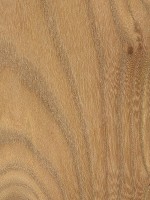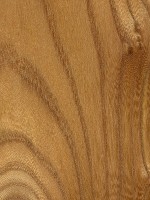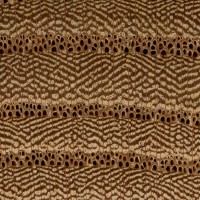 |
Common Name(s): Red Elm, Slippery Elm, Soft Elm Scientific Name: Ulmus rubra Distribution: Eastern to Midwest United States Tree Size: 50-80 ft (15-24 m) tall, 2-3 ft (.6-1 m) trunk diameter Average Dried Weight: 38 lbs/ft3 (600 kg/m3) Specific Gravity (Basic, 12% MC): .48, .60 Janka Hardness: 860 lbf (3,830 N) Modulus of Rupture: 13,000 lbf/in2 (89.7 MPa) Elastic Modulus: 1,490,000 lbf/in2 (10.28 GPa) Crushing Strength: 6,360 lbf/in2 (43.9 MPa) Shrinkage: Radial: 4.9%, Tangential: 8.9%, Volumetric: 13.8%, T/R Ratio: 1.8 |
Color/Appearance: Heartwood is light to medium reddish brown. Paler sapwood is usually well defined.
Grain/Texture: Grain is interlocked (making it very resistant to splitting). With a somewhat coarse, uneven texture.
Endgrain: Ring-porous; large to very large earlywood pores in a continuous row two to four pores wide, small latewood pores in wavy bands; tyloses occasionally present in earlywood; growth rings distinct; parenchyma vasicentric and confluent; medium rays, spacing normal.
Rot Resistance: Rated as non-durable; susceptible to insect attack. Living trees are susceptible to Dutch elm disease.
Workability: Can be a challenge to work because of interlocked grain, especially on quartersawn surfaces. Planing can cause tearout and/or fuzzy surfaces. Poor dimensional stability. Glues, stains, and finishes well. Responds well to steam bending, and holds nails and screws well.
Odor: Elm usually has a strong, unpleasant smell when green; though once dried has very little odor.
Allergies/Toxicity: Although severe reactions are quite uncommon, Elm in the Ulmus genus has been reported as a sensitizer. Usually most common reactions simply include eye and skin irritation. See the articles Wood Allergies and Toxicity and Wood Dust Safety for more information.
Pricing/Availability: Should be moderately priced, though availability from mature trees has been greatly diminished by Dutch elm disease.
Sustainability: This wood species is not listed in the CITES Appendices or on the IUCN Red List of Threatened Species.
Common Uses: Boxes, baskets, furniture, hockey sticks, veneer, wood pulp, and papermaking.
Comments: More commonly referred to as Slippery Elm in tree form (so named for its gelatinous inner bark), Ulmus rubra is typically called Red Elm in most woodworking applications, in reference to its reddish heartwood.
Elm trees are commonly infected with Dutch elm disease, a fungal disease spread by elm bark beetles. D.E.D. has wiped out millions of Elm trees worldwide.








Any idea about a Siberian Elm? Also known as Smooth leaf elm, dwarf elm Ulmus Pumila.
End table made with red elm and finished with Danish oil. This wood is beautiful. Superior to oak in my opinion
I cut some red elm trees when we built our house decades ago. I had it sawed, kiln dried, and planed. It’s a beautiful wood and easy to work. This week I built this doll cradle for my granddaughter and finished it with Tried & True varnish oil. Turned out great! I’ve also built cabinets and bed headboards with storage with red elm and never had any bad luck with it.
I just got some green from a local arborist, the smell reminds me of a horse stable, not entirely unpleasant but also not good.
I’ve built tables for my daughter and had no problem with workability. Looks outstanding.
Can you honeycomb red elm? And if so how?
I got a sample piece of green wood from a friend who had a tree blown over on his farm. He asked me if it was walnut I know its not walnut but not sure what it is. it has an strong smell to it. Kind of stinks. Its a reddish color. When I turned a bowl on my lathe it turned very nice. I would appreciate if someone could help me with identifying it so I could tell my friend if i wanted the log or not. I was thinking maybe red elm or sassafras.
Sassafras smells good and is nothing like red elm. This does look like red elm or slippery elm. Was the inner bark slippery or gel like ?
Hi there. I got a deal on some clear cedar from a barn find. It’s very dark red after planing with no smell. Very lightweight so I’m wandering if it’s this red elm. Can I send a picture somewhere for you to view?
You can attach pictures to these comments. There’s a little paper clip icon where you can upload pics.
Trying to add pictures?
Didn’t come through, sorry.
I just removed 2’ diameter red elm. Color distinct. It is the stringiest stuff EVER. It makes AMERICAN elm seem like splitting white ash. I failed to dent with splitting maul.
I thought I saw a video of elm being used to make marine pulley blocks. I wonder if it’s red elm?
It would be good for that, not just because the wood basically does not split, but a little known property is that it’s heartwood is the most rot-resistant elm wood, especially rot-resistant underwater. And the grain pattern is beautiful.
I have a log I want to make a bow out of, I do not know what it is exactly. I think it is a slippery elm because it has a gooey cambium, also because of the wood color. It is very hard, I cannot dent it with my nail, also when trying to split it in half with a dull hatchet I had no luck. I ended up sawing it in half, the hatchet got stuck for a while in it it is so hard. It does smell, and I have seen a few similar trees such as the… Read more »
I put it down for flooring in my house and put on a slight reddish stain on it. Beautiful in my opinion. Have gotten many good comments on it Used a 4 in wide board
I have worked with Red Elm In wisconsin
it is very pungent and identifiable as such
an acidic horse piss kind of smell
wonderful wood I have built two timber frames with it